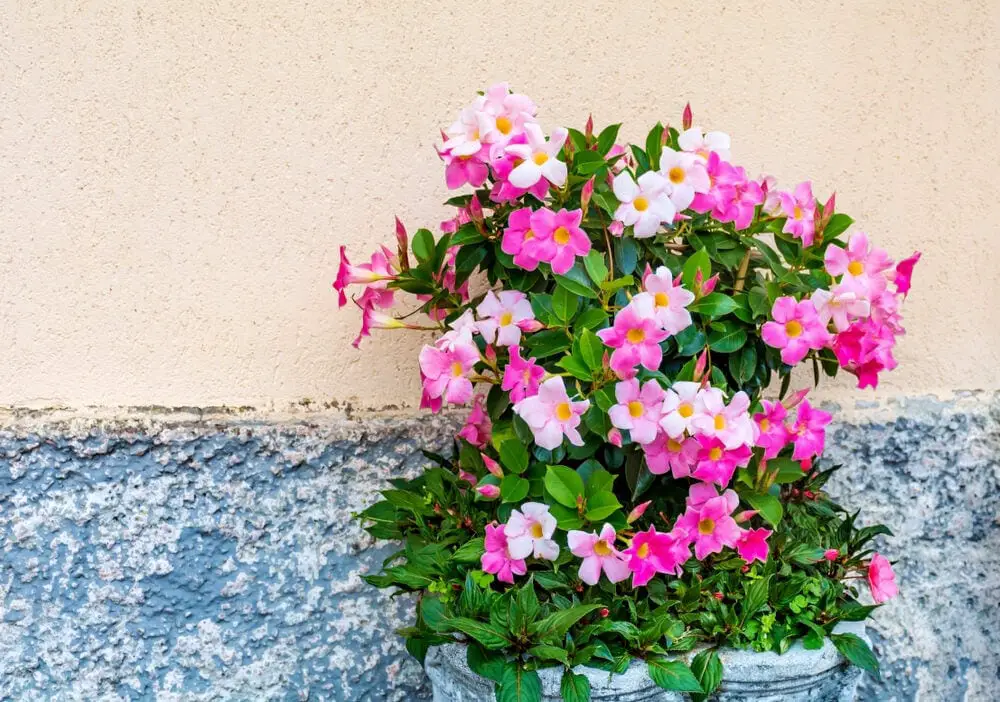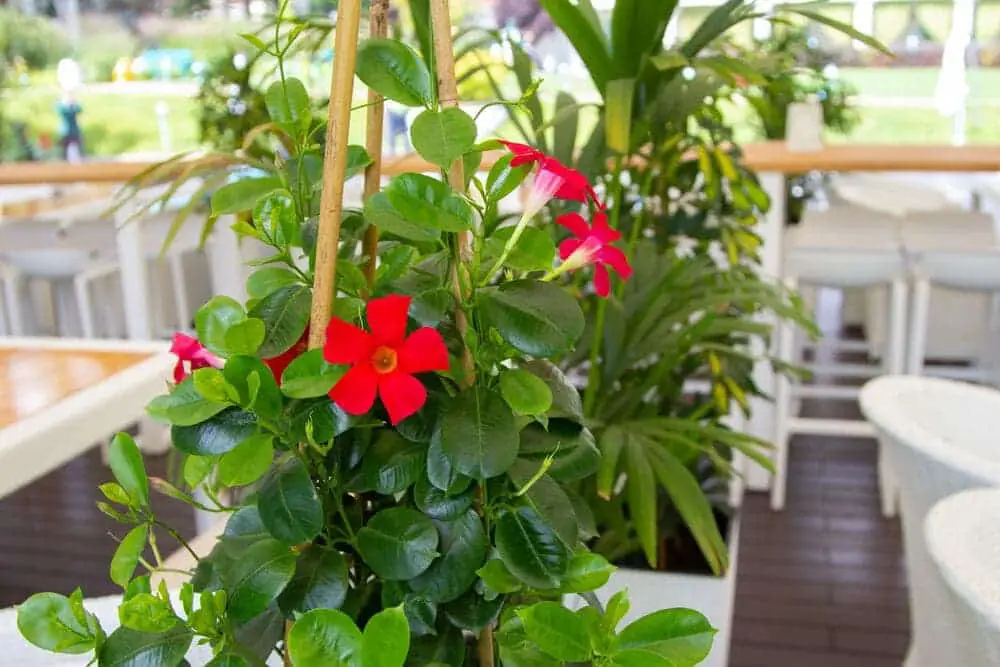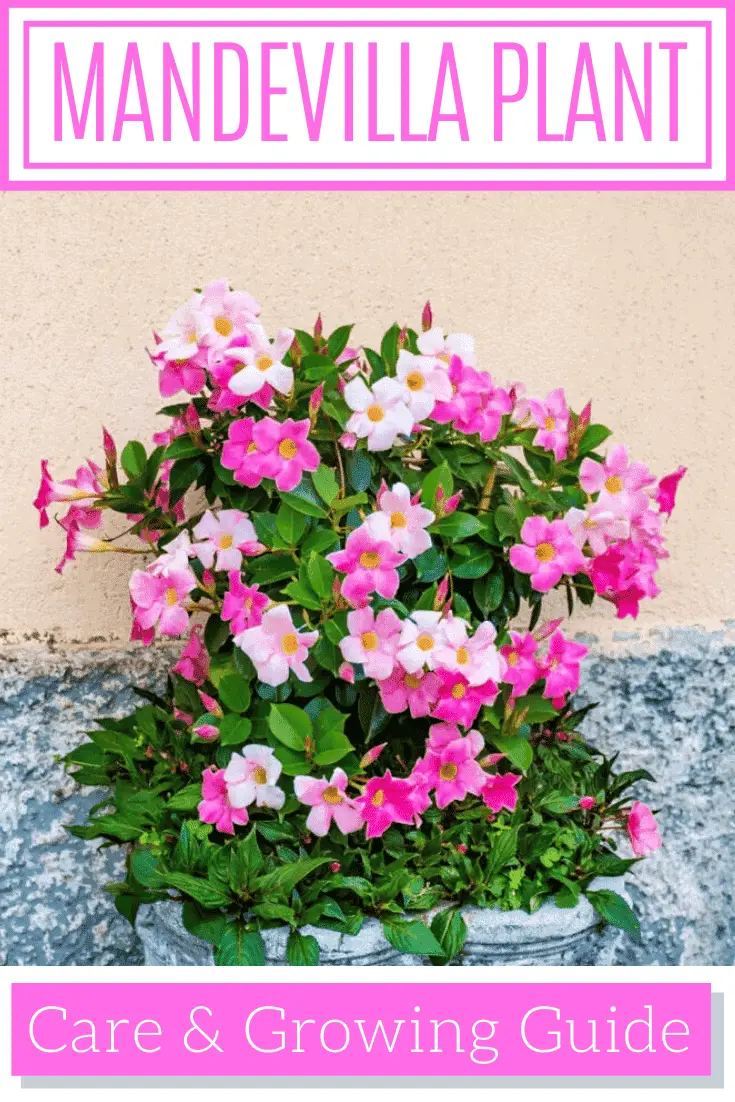This unique plant will need either a trellis to grow on or you can just put it in a planter and hang it or use a plant stand.
When you display this beautiful plant with its dark-green leaves and magnificent flowers at eye level, you will have a stunning conversation piece. It will capture everyone’s attention.
Mandevilla Plant Care & Growing Guide
1. Light Requirement
Indoors, the Mandevilla plant will thrive by a sunny window and outside it needs a semi-sunny spot. In the summer, you can move your plant outside to give it more blooming power. It will bloom to its full potential if the Mandevilla plant receives indirect sunlight all day. They can be grown in full sunshine but they seem to thrive better with a bit shade to keep them cool on a really hot day.
Plant it in an area that receives morning sun but has some shade during the peak midday hours.
2. Water
Make sure that you water your Mandevilla plant thoroughly. In between watering let the top inch dry out before you re-water them. In a planter, the pot should have adequate drain holes. One thing you can do is provide a slow trickle watering system to slowly release the water into the soil so there are adequate moisture levels continually.
3. Soil
The soil should be a potting mix that is fast draining. If you use an all-purpose potting mix, you should add a little perlite to the mixture. The Mandevilla plant needs a high-phosphorous fertilizer every two weeks when it is growing and flowering.
The soil for a Mandevilla plant needs to be rich in nutrients like calcium and nitrogen so make sure when choosing potting soil, it has these two nutrients in there. The soil also need to be loamy and loose for adequate draining and to hold the right amount of nutrients.
After planting, do not fertilize for at least three to four months to prevent any nutrients from burning the root system due to the addition of fertilizer. After 6-12 months old, use a slow-release fertilizer that has been diluted with water.
4. Temperature
When the temperature drops to 55 degrees Fahrenheit or below at night, the plant will need to be brought back inside. The average temperature should be between 65-85 degrees Fahrenheit.

5. Repotting
To keep it growing nicely, every spring you will need to take your indoor Mandevilla plant and repot it. Just make sure that the new pot is one size bigger than the one it was in. Make sure that it has adequate drainage.
6. Speed of Growth
The Mandevilla plant is a fast grower so you need to be sure that you have it where it can climb. Because they like to grow, climb, and spread, plant them three feet apart.
7. Height and Spread
If you do not trim your Mandevilla plant, it can grow up to 10 feet.
8. Flowers
The flowers of a Mandevilla are big and trumpet-shaped that bloom from spring to fall. The flower buds open to reveal white, red, yellow, or pink petals with yellow throat flowers.
9. Trimming
If you have your Mandevilla plant in a planter, you will want to trim it back unless you want a huge shrub. To help control the size, you will need to prune it back in late fall. If necessary, you can trim it back by half. Pinch off the spent blooms so more will grow. When you prune it, you will get more blooms because the flowers are found at the tips of any new branches.
When you trim your Mandevilla plant, do it so the air circulation around the foliage is better.

Is Mandevilla Poisonous?
If they are eaten by humans or pets, they are considered mildly toxic. This includes all parts of the plant. You may experience mild indigestion. You could develop a skin irritation because of the milky sap a Mandevilla plant produces so you may consider wearing gloves.
Can Mandevilla grow in Water?
No, you cannot grow a Mandevilla plant in water
How to get Mandevilla to Flower?
You need to make sure that you have the right amount of water, right temperatures, and the right soil to flower.
More like this: Snake Plant (Sansevieria Trifasciata) Care & Growing Guide
Common Plant Diseases
Mandevilla is prone to a variety of diseases, including:
- Dropped or yellow leaves—this is a sign of overwatering or the temperatures were too cold for the plant. To solve this issue, do not water it as much and keep the plant warm.
- Root rot—this can happen if the roots sit in soggy soil. When watering, spray down the leaves to remove any debris or dust on the leaves so it will not saturate the soil
- Ants or aphids—get rid of them by using a strong blast of water from the hose or use an organic pesticide.
- Mealy bugs—these generally appear when the plant is not getting enough water so make sure it is getting enough water.
- Spider mite—these occur when the weather conditions are too hot. You can also use an organic pesticide or a neem oil solution to get rid of them.
Keep reading:
Conclusion
- It is an evergreen sub-shrub with vining stems that are densely covered with dark-green, glossy oval leaves.
- You will need a trellis to support the twining, vigorous stems and show off the beautiful flowers. Tie the vines loosely to the trellis so you do not restrict growth. It may be needed re-tied as it grows.
- Make sure that you over-winter your plant indoors unless you have a warm climate year-round.
- The flowers are great for attracting hummingbirds as they love to sip at the nectar of the flowers.
- To prevent any strong winds from damaging or shifting the plant you need to make sure you tie it down.
- It is advisable that when you are ready to pot your Mandevilla plant that you put a layer of gravel at the bottom of the planter. This will help to improve drainage. You can also help with water retention by mixing some perlite in the soil mixture.

Victoria is the owner and main author of hobby plants. She loves spending her free time in her garden planting and taking care of her plants. Victoria hopes you enjoy the content here!
![Mother Of Thousands Plant [Complete Plant Care Guide] Mother Of Thousands Plant [Complete Plant Care Guide]](https://www.hobbyplants.com/wp-content/uploads/2022/07/mother-of-thousands-plant-300x158.jpg)
![Majesty Palm Plant Care: [Complete Beginner's Guide] Majesty Palm Plant Care: [Complete Beginner's Guide]](https://www.hobbyplants.com/wp-content/uploads/2022/08/majesty-palm-care-300x158.jpg)
![Exotic Angel Plant Care: [Complete Beginner's Guide] Exotic Angel Plant Care: [Complete Beginner's Guide]](https://www.hobbyplants.com/wp-content/uploads/2022/08/exotic-angel-plant-care-300x158.jpg)
![Snow White Waffle Plant: [Complete Care Guide] Snow White Waffle Plant: [Complete Care Guide]](https://www.hobbyplants.com/wp-content/uploads/2022/08/snow-white-waffle-plant-300x158.jpg)
![Waffle Plant Care: [Complete Beginner's Guide] Waffle Plant Care: [Complete Beginner's Guide]](https://www.hobbyplants.com/wp-content/uploads/2022/08/waffle-plant-300x158.jpg)
![Bird Of Paradise Plant Care: [Complete Beginner's Guide] Bird Of Paradise Plant Care: [Complete Beginner's Guide]](https://www.hobbyplants.com/wp-content/uploads/2022/08/bird-of-paradise-plant-300x158.jpg)
![Purple Passion Plant Care: [Complete Beginner's Guide] Purple Passion Plant Care: [Complete Beginner's Guide]](https://www.hobbyplants.com/wp-content/uploads/2022/08/purple-passion-plant-care-300x158.jpg)
![China Doll Plant Care: [Complete Beginner's Guide] China Doll Plant Care: [Complete Beginner's Guide]](https://www.hobbyplants.com/wp-content/uploads/2022/09/china-doll-plant-care-300x158.jpg)
![Polka Dot Plant Care: [Complete Beginner's Guide] Polka Dot Plant Care: [Complete Beginner's Guide]](https://www.hobbyplants.com/wp-content/uploads/2022/09/polka-dot-plant-300x158.jpg)
![Mona Lisa Lipstick Plant Care: [Complete Beginner's Guide] Mona Lisa Lipstick Plant Care: [Complete Beginner's Guide]](https://www.hobbyplants.com/wp-content/uploads/2022/09/lipstick-plant-mona-lisa-300x158.jpg)
![Yucca Cane Plant Care: [Complete Beginner's Guide] Yucca Cane Plant Care: [Complete Beginner's Guide]](https://www.hobbyplants.com/wp-content/uploads/2022/09/yucca-cane-plant-care-300x158.jpg)
![Bush On Fire Croton Plant Care: [Complete Beginner's Guide] Bush On Fire Croton Plant Care: [Complete Beginner's Guide]](https://www.hobbyplants.com/wp-content/uploads/2022/09/bush-on-fire-croton-300x158.jpg)